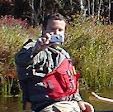 |
| Surfing the on the upper Jeremy |
I’m off to an early start. I had my first swim of the year at the Route 149 Rapid (aka “ the Old Dam Rapid” or the “Old Mill Rapid”, or simply “where the old dam was”) on the Jeremy River.
After another week of rain and snowmelt, I got an email from Paul asking if I’d be interested in another run on the Salmon. After a ten-year absence, this would be my second run on the Salmon/Jeremy in three weeks. We met at the covered bridge on Comstock Bridge Road in East Hampton. On this trip the canoes (me and Jim) outnumbered the kayak (Paul). The river was low but fluid – 4-feet, 600 cfs. We ran the shuttle up the commuter lot at the intersection of Routes 2 and 149.
 |
Route 149 Rapid - I swam
the drop at the top |
The Jeremy starts off small, and at this level rock dodging was the order of the day. About a mile downstream is the site of an old paper mill dam that has now been removed revealing a new rapid with two drops. The first is a 1 - 2-foot drop where the river takes a hard right turn and Pine Brook joins the river. There is a large wave at the bottom breaking to the right. The second is a 2-foot drop through a jumble of rocks where the old dam stood. The line is to the right of the rocks at the bottom.
I drifted down the first drop without much momentum, got spun sideways on the breaking wave, and flipped to my offside – first swim of the year. After a feeble attempt to try to get my boat to shore, I let Jim chase it down and focused on getting myself to shore before the next drop.
 |
| Running the broken dam |
My boat ran the next drop and Jim got it to shore for me below the Route 149 Bridge. The rest of the run was uneventful. From there down the Jeremy is a little bigger with the added flow from Pine Brook, but it was still all about dodging rocks and staying in the deep water channels. The Salmon was actually at a fun level with lots of rocks to dodge, eddies to catch and waves to surf. Paul says 4-feet is his favorite level.
I ran the broken dam first, and was able to get some pictures and video of Jim and Paul coming through. We took turns surfing at the surf wave below the broken dam before heading down to the take-out at the covered bridge. Lesson learned from this trip – don’t just drift into breaking waves at the bottom of a drop. Paddle into it with some momentum so you can break through without flipping. Living the old saying - “if you not swimming you are not trying hard enough”.



















































